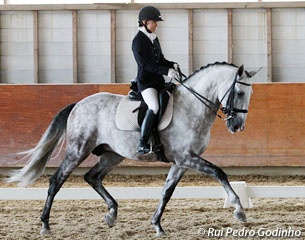
I used to love doing circles. In fact, right up until my last pony retired I could go around and around all day on a 20, 10, or 8 metre circles with great precision and balance. However, as the horses I rode got bigger and stronger, and their gaits increased in both height and length, I no longer enjoyed the circle so much.
I must admit for a long time I avoided the circle wherever possible and found that bounding freely up the long side made me seem far more in control and, well, a slightly more harmonious picture. The reason, of course, is that the circle is a test of the rider’s control over not only the balance, but the cadence and tempo of the horse, and what was very easy to achieve on a pony is made a lot more difficult when the centre of gravity is increased by a foot or two!
"The circle is the major figure of the entire dressage. It is on the circle that we establish the tempo," said Nuno Oliveira.
My trainer quickly noticed my subtle avoidance of the circle, particularly the ten metres or lesser ones, and he knew too that it was a tool I greatly needed to practice, not just for the improvement in my horse's strength but also for my control over the tempo and engagement of the horse.
First, we set out to avoid the all too easy trap of turning the circle by puling on the inside rein, which of course makes you lose the cadence and the outside shoulder simultaneously and you pull the horse in some sort of unbalanced spin. Instead, we established the channels, creating an even tension on both reins on each side and gently guiding the horse through that channel and around a solid inside leg acting downwards like a post, by guiding him with the torso and allowing the outside shoulder to advance.
"In the circle we must feel that we don't need to use the outside rein anymore than the inside rein. We need to feel the same intensity of contact on both. In a circle the reins must have an equal degree of tension and it is the outside shoulder that advances,” Nuno Oliveira explained.
Nuno used the circle not for “the pleasure of walking around,” but as a tool to verify and improve the cadence, impulsion, contact, or position of the head, and I found very quickly that the oh-so-simple circle was a loud speaker for all the things that was weak in our partnership.
If you begin a circle and the horse falls on the inside shoulder, do you really have control of the inside of the horse? If you are half-way around the circle and you lose the tempo and cadence of the trot, did you lose it out the side of the horse because the energy is no longer being channelled through two even reins? If you lose the horse out the back door and feel like you are about to halt half-way through, is the horse engaged and stepping up into an even contact? If you get half-way and have to pull on either rein, is the outside shoulder of the horse moving around your inside leg, or are you steering him around with your hands? Do you look up and around to where you are going, or do you look at a lovely spot on the ground and pivot your way quickly around it?
The key is to secure an even pathway for your horse to enter to turn your shoulders through the corridor you have created with two even reins, and to gently guide the horse around the circle, while looking at the line you will take and not at a point on the ground.
“If, when doing a circle, you feel the same intensity of contact on the inside rein as the outside rein, it is because the horse is busy doing a correct circle," Oliveira stated.
Mission accomplished! if only it was that easy!
by Sarah Warne for Eurodressage
Related Links
Classical Training: Making Corners Count
Classical Training: The Geometry of Dressage